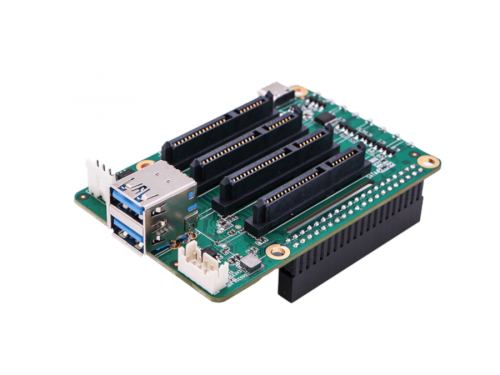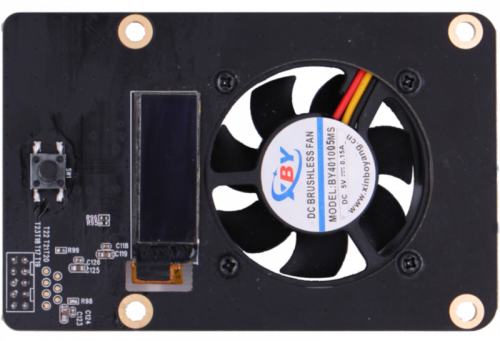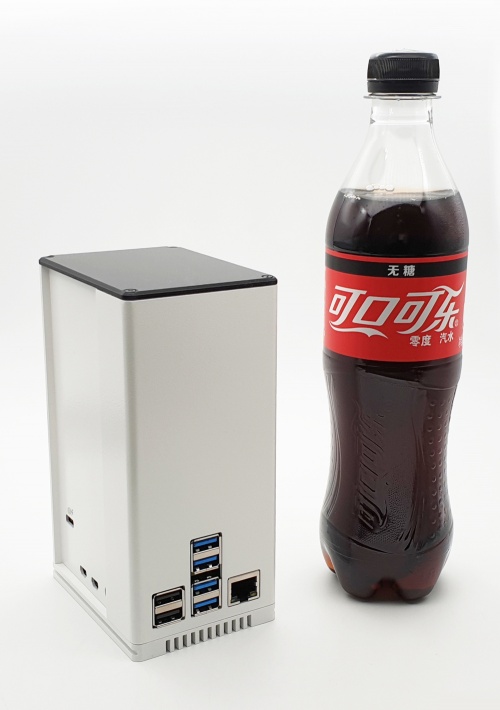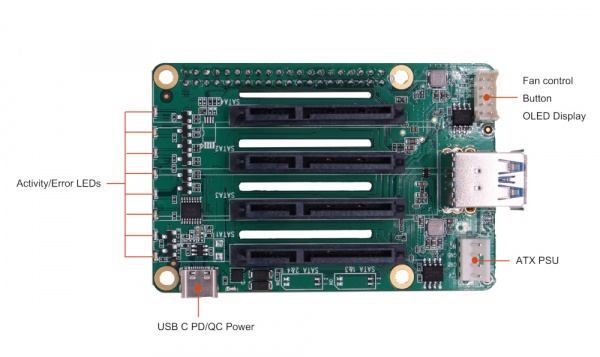Difference between revisions of "Dual Quad SATA HAT"
| Line 29: | Line 29: | ||
Just copy the command above and paste it into the terminal and press enter. If you want more settings, check out section Software Configuration at the bottom of the page. | Just copy the command above and paste it into the terminal and press enter. If you want more settings, check out section Software Configuration at the bottom of the page. | ||
| + | |||
| + | '''In particular, users of [https://ubuntu.com/download/raspberry-pi Ubuntu]''', please use the installation script below: | ||
| + | |||
| + | curl -sL https://rock.sh/get-sata-ubuntu | sudo -E bash - | ||
=== Upgrade firmware === | === Upgrade firmware === | ||
Revision as of 06:38, 23 July 2020
Home > SATA HAT > Dual/Quad SATA HAT
Introduction
Contents
ROCK Pi Dual/Quad SATA HAT is an addon HAT designed for Raspberry Pi 4. It utilizes the high speed USB3 buses on Raspberry Pi 4 and providing a complete NAS solution based on Raspberry Pi 4. It has the following features:
- Up to 4x HDD/SSD, support 2.5inch or 3.5inch SSD
- Utilize two independent USB3 buses on Raspberry Pi 4
- Type C power input with USB PD support for both 2.5inch SSD and Raspberry Pi 4(v1.1 hardware)
- 12V DC power input for 2.5 and 3.5 inch HDD and Raspberry Pi 4(v1.2 hardware)
- External standard ATX power supply support for 3.5inch HDD
- Support HDD suspend mode
- Support software RAID 0/1/5
- Support USB Direct Access Mode from PC
- Optional PWM control fan for HDD heat dispatching
- Optional OLED display for IP/Storage info
Software support
We provide a install script to help you get the SATA software that works in Raspberry Pi 4B.
curl -sL https://rock.sh/get-rockpi-sata | sudo -E bash -
Just copy the command above and paste it into the terminal and press enter. If you want more settings, check out section Software Configuration at the bottom of the page.
In particular, users of Ubuntu, please use the installation script below:
curl -sL https://rock.sh/get-sata-ubuntu | sudo -E bash -
Upgrade firmware
1. How to upgrade F/W with jms561 under Raspberry Pi
2. How to upgrade F/W with jms561 under Windows (WIP)
NAS support(optional)
OpenMediaVault
Install: Installing OMV5 on Raspberry PI's
Troubleshooting:
1. OMV WebUI only shows two HDD's
This is likely because JMicron controllers incorrectly report identical serial numbers and other data which confuses various systems.
You can “fix” this by adding a rule to /lib/udev/rules.d/60-persistent-storage.rules after the entry for “Fall back usb_id for USB devices”:
# Fix Quad SATA HAT disk serial number
KERNEL=="sd*", ATTRS{idVendor}=="1058", ATTRS{idProduct}=="0a10", SUBSYSTEMS=="usb", PROGRAM="/root/serial.sh %k", ENV{ID_SERIAL}="USB-%c", ENV{ID_SERIAL_SHORT}="%c"
You will also need to create /root/serial.sh containing the following:
#!/bin/bash
/sbin/hdparm -I /dev/$1 | grep 'Serial Number' | awk '{print $3}'
And you need to add execute permission to the file via the following:
chmod +x /root/serial.sh
This will ensure that unique paths are created based on the serial number of the actual drives and not the hat.
Supplied with this product
Dual version
- ROCK Pi Dual SATA HAT
- Mechanical spacers
- 2x USB 3.0 connection adapter *1
- CPU heatsink with fan(DF4 version only)
Quad version
- ROCK Pi Quad SATA HAT
- Mechanical spacers
- 4x USB 3.0 connection adapter *1
- CPU heatsink with fan(DF4 version only)
SATA HAT Top board(Optional)
- 0.91inch OLED
- One GPIO button
- PWM controlled 40x40mm FAN
Metal Case(Optional)
- Holds up to four 2.5 inch HDDs/SSDs
- Supports top board
- Top acrylic cover for OLED display
- Support fan for HDD heat dispatching air flow
- One button for powering off and OLED info switch
Other hardware needed
- Proper power adapter(Check power options below for more info)
- 2.5inch or 3.5inch HDD/SSD
- Raspberry Pi 4 or ROCK Pi 4 with OS running
- optional 7+15P SATA cable(For 3.5inch HDD or extending the length)
Model Number
Since the Raspberry Pi 4 changes the form factor(swapping USB and RJ45), we need different USB connection adapter. The ROCK Pi 4 shares form factor with Raspberry Pi 3/3B+. Below is the different model number:
| Model | Description |
|---|---|
| DF4 | Dual version for Raspberry Pi 4 |
| QF3 | Quad version for ROCK Pi 4, Raspberry Pi 3/3B+ |
| QF4 | Quad version for Raspberry Pi 4 |
PINOUT
Pinout for 40PIN GPIO header
| Description | Function | Pin# | Pin# | Function | Description | |
|---|---|---|---|---|---|---|
| 1 | 2 | VCC5V0_SYS | ||||
| OLED I2C | I2C_SDA | 3 | 4 | VCC5V0_SYS | ||
| OLED I2C | I2C_SCL | 5 | 6 | |||
| 7 | 8 | |||||
| 9 | 10 | |||||
| top board key | GPIO4_C2 | 11 | 12 | |||
| GPIO4_C6 | 13 | 14 | ||||
| 15 | 16 | GPIO4_D2 | reset OLED | |||
| 17 | 18 | |||||
| 19 | 20 | |||||
| 21 | 22 | GPIO_RST1 | reset SATA1/2 | |||
| 23 | 24 | |||||
| 25 | 26 | ADC_IN0 | ||||
| SDA | 27 | 28 | SCL | |||
| 29 | 30 | |||||
| 31 | 32 | |||||
| control tb-fan speed | PWM_33 | 33 | 34 | |||
| 35 | 36 | |||||
| reset SATA3/4 | GPIO_RST2 | 37 | 38 | |||
| 39 | 40 |
Pinout for 2x5 PHD 2.0mm connector
| Function | Pin# | Pin# | Function | |
|---|---|---|---|---|
| I2C_SDA | 1 | 2 | VCC3V3_SYS | |
| I2C_SCL | 3 | 4 | VCC5V0_SYS | |
| GPIO4_D2 | 5 | 6 | GPIO4_C2 | |
| GND | 7 | 8 | PWM_33 | |
| GND | 9 | 10 | NC |
Getting Started
Assemble the Kits
Full Setup Quad Sata Hat for Raspberry Pi 4 NAS Review
Detail of the HAT board
Power Options
Power consumptions for typical disks:
| Power Consumption | |
|---|---|
| SSD | <3W |
| 2.5 HDD | 3 ~ 5W |
| 3.5 HDD | 5 ~10W |
Note: the table above is for reference, check your disk label for the exact power consumption. More info can be found here.
Option 1: Powering from Raspberry Pi/ROCK Pi 40P GPIO header
The Raspberry Pi GPIO +5V can provide up to 1.5A power, the typical SSD is 3W power consumption. So you can drive up to two SSDs directly powering from Raspberry Pi with good 5V/5A USB C power adapter.
The ROCK Pi 4 GPIO +5V can provide up to 4A current. You can drive four SSD/HDD directly if your power adapter can provide > 35W power.
Option 2: Powering from USB C or DC Jack on SATA HAT
V1.1 SATA HAT
For V1.1 hardware revision, we use USB C for the power input on SATA HAT with PD/QC support. Same as option 1, you can choose USB PD power adapter > 35W to driver up to four 2.5inch HDDs and Raspberry PI at the same time. 3.5inch HDD powering is not supported from the USB C port.
V1.2 SATA HAT
For V1.2, we changed the power jack on SATA HAT to 12V DC because the 12V power adapter is much cheaper than USB C PD adapter. Also, users want to power 3.5inch HDD with power adapter instead of ATX PSU. The 12V DC jack is 5.5x2.1mm diameter. You need at least 12V/3A to power four 2.5inch HDD and 12V/5A to power four 3.5inch HDD.
Option 3: Powering from ATX PSU
If you plan to put the SATA HAT in a PC enclosure, then you can use the ATX PSU. Mostly ATX PSU can meet the power requirement. You need a ATX Floppy cable to power the SATA HAT and Raspberry Pi.
Software configuration
Just edit /etc/rockpi-sata.conf, take it effect by below command
sudo systemctl restart rockpi-sata.service
Below is the default /etc/rockpi-sata.conf, which you can modify according to the comments
[fan]# When the temperature is above lv0 (35'C), the fan at 25% power,
# and lv1 at 50% power, lv2 at 75% power, lv3 at 100% power.
# When the temperature is below lv0, the fan is turned off.
# You can change these values if necessary.
lv0 = 35
lv1 = 40
lv2 = 45
lv3 = 50
[key]# You can customize the function of the key, currently available functions are
# slider: oled display next page
# switch: fan turn on/off switch
# reboot, poweroff
# If you have any good suggestions for key functions,
# please add an issue on https://rock.sh/rockpi-sata
click = slider
twice = switch
press = none
[time]# twice: maximum time between double clicking (seconds)
# press: long press time (seconds)
twice = 0.7
press = 1.8
[slider]# Whether the oled auto display next page and the time interval (seconds)
auto = true
time = 10
[oled]# Whether rotate the text of oled 180 degrees, whether use Fahrenheitrotate = false
f-temp = false
SATA HAT Firmware Update
See Forum Discussion -> How to upgrade F/W with jms561 under Raspberry Pi
Troubleshooting
1. Quad SATA HAT Assembly and Troubleshooting




